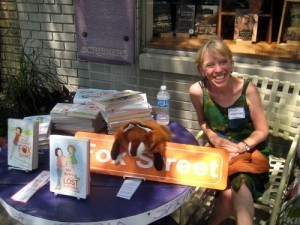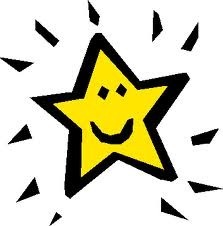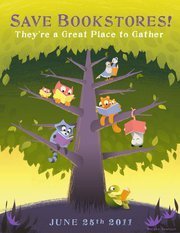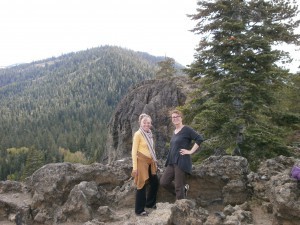Tricia Springstubb's Blog, page 24
July 12, 2012
Banana Popsicles
Yeah–that’s what got me through. That, and the amazing people who actually came to an OUTDOOR book festival located on a CEMENT SIDEWALK beside a BRICK BUILDING on a day when the temperature was in the high 90s and the humidity was approximately 15000 %. Here I am, and if you think I look bad now, you should’ve been there later, when my nametag somehow got stuck in my armpit.
As you can see, even my Faithful Fox had had it. Still, thanks very much to the intrepid Harriet, indie book store goddess, and all her helpers in their pretty purple sundresses.
Cheers, too, to my friend Laura Walter, who took the photo and looked especially fetching in her we-are-about-to-encounter-kryptonite sunglasses and cute baseball cap. Jeers, however, to the man who stood beside my table busying himself with his deluxe phone. I had a sneaky hope he was about to show me a nice review of one of my books, and smiled up at him encouragingly. Instead, he intoned “97 degrees” and showed me the numbers to prove it.
More soon…
July 5, 2012
We and the ten students we chaperoned left Japan late Sun...
We and the ten students we chaperoned left Japan late Sunday morning and arrived in Cleveland Sunday afternoon. The kids into time travel/teleporting got off on this, and I thought of fairy tales where a character returns from legions of extraordinary adventures only to find a single second of real life has elapsed. The rational side of me feebly tried to erect a few thoughts on the arbitrariness of borders and time, but it was no use. We’d been away, very far away, and that was all.

A tea house in Kyoto--peace out!
Japan is beautiful, spooky, gracious. Japan is not America. Our first afternoon there we wandered outside the village where we did home stay and up into the mountains, through a misty bamboo grove, past a graveyard where the faces of the Buddhas were worn to masks, and stopped to smell the gardenias blooming on a bush the size of a Volgswagen. The flowers and gardens–moss, stone, water–I understood, but again and again Paul and I caught ourselves speculating on what, exactly, we were looking at, everything from the symbolism of the shrines to the bottles in the vending machines (the vending machines! they’re everywhere, and we developed favorites–the dark, sweet, iced coffee called Boss as well as CC Lemon, which claimed to pack the vitamin C of 70 lemons into every bottle). As valiantly as Paul had tried to learn the language, that, too, was nearly impenetrable. I have long quoted Rilke’s “Try to lead the uninterpreted life,” and for two and a half weeks we had little choice.

The Golden Pavilion
We’ve never met kinder, more considerate people. Warning: never ask for directions unless you can handle a person dropping everything and escorting you two or three blocks. Even in wild, stylish Tokyo, there’s a civil sort of hush over things. People dress so beautifully, always in muted colors–grays, beiges, black. Women laugh behind their hands. The workers all wear uniforms, and the taxi drivers cover the seats of their cabs with doilies. Though finding a trash can is nearly impossible, you never see a speck of garbage on the sidewalks, and I wondered if everyone we passed had a wadded up candy wrapper or crushed pop can stowed in their stylish bags. Paul claimed even the crows–lord, the size of those crows!–were less raucous than their American counterparts. As soon as I got home, I re-read “Crow Boy”, one of my all-time favorite picture books and now all the more moving.
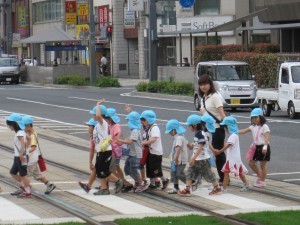
Field trip in Hiroshima
I scratched the surface of Japanese mythology, but want to know more. Each Shinto shrine honored some deity–we saw statues of foxes, mice, Buddhas wearing baby bibs. Japan is a country of festivals, because the Shinto gods, rather than be adored, prefer being entertained. Everyone told us to come back in the fall, when the mountains rage with color.
The students were terrific travelers and outdid me in their adventurousness. The girls bought Lolita costumes. On the last night they all went to a public bath we found down a tiny Tokyo alley. My only complaint is that I’d forgotten how much teenagers eat. Having ten kids suddenly turn to you and say “What’s for dinner?” is sweat-inducing. By the end everyone’s money was running out–did I mention that Japan is crazy expensive?–and one night Zach, in an effort to economize, ordered the cheapest thing on the menu at a noodle shop. It turned out to be cold soba with a raw egg on top. He ate it.
We’re back. But one suitcase is still only partly unpacked. I want to keep one foot (in a house, not street, shoe) back there still.
June 28, 2012
An Eclectic List
Here’s one more guest post, this time from my dear New York friend, Mary Norris. Mary is deputy-head of the copyediting department at the New Yorker, so you know you need to listen to what she has to say. You can find Mary blogging on some of my favorite subjects, including commas and pencils, at www.newyorker.com and at her highly original and hilarious blog on life in the city with a car, www.alternatesideparking.blogspot.com
Here’s Mary:
I loved the Summer Reading Club at the library of my childhood. The goal was to read ten books, and there was some kind of a system for keeping track: gold stars or red dots or filled-in squares. I still think of summer as a season for reading—for pure entertainment instead of school—and because I now spend the summer at the beach and have a long commute to work, I am especially intent on having a good supply of books. Fortunately, where I work there is a book bench piled with reviewcopies for the taking. I can never resist anything about the sea. Or Greece. Or Italy.Or Catholics. Or Freud. Or celebrity-chef memoirs. Today I picked up a copy of “The
Complete Dead Sea Scrolls in English.” If I had any sense, I would put it back.
Here is my list for the summer of 2012:
1. “Surviving the Shark: A Surfer’s Terrifying Tale of a Brutal Attack by a Great White,” by Jonathan Kathrein with Margaret Kathrein. The author was
sixteen when a shark sank its teeth into his leg while he was surfing off the
coast of Marin County, California. I have gotten as far as his decision, in the
hospital, to speak in defense of the shark.
2. “Seaworthy: A Swordboat Captain Returns to the Sea,” by Linda Greenlaw.
I’m now halfway through this account of a fishing expedition on the Grand
Banks. I’m not that interested in fishing, but I love stuff about boats, and this
one is by a lady skipper, the captain of one of the boats that Sebastian Junger
wrote about in “The Perfect Storm.”
3. “How to Sharpen Pencils,” by David Rees. A hilarious, poignant, straight-faced manual for pencil enthusiasts. I hope to visit the Pencil-Sharpener Museum in Logan, Ohio, with the author.
4. “The Pencil: A History of Design and Circumstance,” by Henry Petroski.
I should have read this years ago, but have only recently embraced my penicilophilia.
5. “That Is All,” by John Hodgman. I met Hodgman, who appears occasionally on “The Daily Show,” while I was waiting for David Rees to sign my copyof “How to Sharpen Pencils” and felt obliged to buy his book, too. He is a young guy,with a fertile imagination, and he writes for other young guys with fertile imaginations. I think he was briefly a millionaire for some reason.
6. “Privacy,” by Garret Keizer. From a series called Big Ideas/small books, put out by Picador. Garret Keizer is a terrific writer who I happen to know from graduate school. He and his wife, Kathy, helped me plant my first vegetable garden. I know he will be good company on the A train.
7. “God’s Hotel,” by Victoria Sweet. I love medical literature, and this is about a very compassionate rehab facility in California, and promises to have lots of gory details and case histories.
8. “The Immortal Life of Henrietta Lacks,” by Rebecca Skloot. This has been on my shelf for a while. I’ve heard nothing but good things about it, but have put off delving into it, even though it counts as medical literature.9. “The Prime Minister,” by Anthony Trollope. I have never read Trollope, who is a big favorite of some people I respect. Plus he was so prolific that he could fill my A train requirements for years to come. His is the only book on this list that I don’t have. Perhaps this calls for a trip to the library.10. To be determined, possibly during that trip to the library.
June 21, 2012
My Friend Susan
I’m (still) traveling–squee!
But my good friend, the poet Susan Grimm, is here to share some thoughts and memories about summer reading. Susan is the author of two poetry collections, Almost Home and Lake Erie Blue, and editor of the collection Weathering the Storm: How to Put Together a Book of Poems. Susan blogs at [email protected]
Susan and her sister, fiction writer Mary Grimm, spent their summers writing stories and playing complicated, imaginary games–think the Brontes, minus the moors and the drunken brother. (By the way, Girl of the Limberlost is on my list to re-read, too). 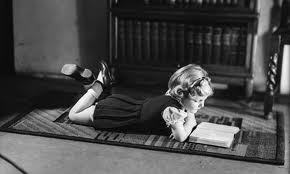 Susan writes:
Susan writes:
When I was little (but not too little), I would read some books over and over. I read The Dandelion Cottage every summer and The Little White Horse even more frequently. I have a hazy idea of both stories, lo, these many years later, but isn’t that how memory always works—I remember one thing and you another. I remember that the four girls in Dandelion Cottage wallpapered some of the rooms of the deserted cottage. (This must have been a time when I still thought I would be domestically gifted.) And I remember the girl in The Little White Horse had a riding habit and a container of biscuits (English for cookies) at the side of her bed.
I was the sort of child who loved the summer reading club’s recognition of what I did all year long. Stars for the books I gobbled. Maybe those librarians were my first audience as I had to recap the story I read. One time, I was tested by a suspicious woman who didn’t believe I could read words like “sewing machine”!
Nowadays, I still like to make lists of what to read during the summer, although it’s not the adult equivalent of Swallows and Amazons (pemmican, “If not duffers . . .”) or The Valley of Adventure (the glittering eyes of the statues and how those Brits always call blankets “rugs”). Usually, I’m looking for something that might be considered heavy reading by some. A book that I’ve somehow neglected or a book that might give me ideas about my own work. One summer involved Moby Dick, another Middlemarch. Recently, I made my way through American Hybrid: A Norton Anthology of New Poetry.
I haven’t made my list for this year although I guess I could start it with the book of poems by Rae Armantrout that I’m reading now.
But maybe I should revisit the things I read in those early years. Just recently, in an extremely oppositional venue (the office where I work), I read The Five Children and It through Daily Lit. (This was a much better choice than Walt Whitman—who I like—but not in this form of delivery.) Every day I would get a little slice of the five children’s adventures, the Psammead’s perverse wish-granting mischief, and the wry, knowing narrator’s voice, sometimes addressing the reader directly. It was still great!
What else could I revisit? The Little Lame Prince, Hetty: Her First Hundred Years, Anne of Green Gables, Caddie Woodlawn, Girl of the Limberlost, A Wrinkle in Time, The Diamond in the Window, A Treasury of Golden Memories, Return to Gone-Away.
June 14, 2012
Where you should be on June 16
I’m writing this before I leave on my Japan trip. As you read, I may be eating sushi (not) or taking the Philospher’s Walk in the mountains outside Kyoto. “The world is so full of a number of things, I’m sure we should all be as happy as kings.”
I’m looking forward to seeing what book stores are like there. Before I leave here, I’ll be stopping into Mac’s Backs, one of the three superb indie bookstores my community is lucky enough to have. Mac’s sells new and used books, and I’ll be stocking up on paperbacks I can shed as I finish them. I’ll have a chat with owner Suzanne, probably the most modest hero I know. Suzanne has been in business for decades, through thick and very thin, and she offers in spades everything you think of when you think bookstore: what you’re looking for, the unexpected find, thoughtful tips, the chance to bump into a neighbor. She hosts book clubs for all ages, as well as readings by nationally known and local writers. Susan hosted the book launch for What Happened on Fox Street, and in September, she’s sponsoring a reading by my writing group (which please come to). All stuff that needs an actual, real live place to occur.
All of which is to say, she and her store are irreplaceable. I’m pleased to note that, midst the endless bad news about book store closings, she and her two local comrades tell me their sales have gone up since the local Borders closed. Not only that, the American Booksellers Association reports that the number of indie book stores rose last year, the third straight year of increase. The Dance of Joy, please!
And yet…these stores need us. Need us bad. They haven’t survived out of luck, but due to their owners’ passion and persistence. Hard as it is to resist the instant gratification lure of Amazon, I do, again and again. Thrilled as I am that my books are available in every format including e-book, I worry a lot about what that means for the brick and mortar places I love.
June 16 is this year’s designated Save The Bookstores Day. Just as every month should be Poetry Month and every day is Children’s Day, we shouldn’t need an official day for shopping our indies, but we do. (It’s also the day before Father’s Day.) Treat yourself to a new or used book–you and your bookstore owner deserve it.
June 7, 2012
Japan
In less than a week, I will be on a plane to Japan. (If you have a big brass gong near at hand, please strike it now!) Busy as things have been around here, and given my compulsive tendency to compartmentalize my life, typing those words “plane to Japan” gives me a shock.
Reasons to be anxious:
**Have never been
**Endless plane ride
**Sushi (do not eat)
**Language (do not speak)
**Knees (do not bend as well as they used to–and I will be spending a lot of time on the floor)
Reasons to be excited:
**Have never been
**Gardens
**Temples
**Noodles
**Husband who was there two years ago and has barely stopped talking about it since
Over the two weeks, we’ll be on our own part of the time, in Kyoto, and the rest of the time with his high school students, at Hiroshima and in Tokyo. For several days we’ll be staying with a family who make their living brewing soy sauce! I have a new journal at the ready.
****
More nice news: On my desk, to finish up before I leave, is the copy-edited manuscript of my chapter book Cody, which Candlewick will publish in 2014. I wish I could reveal the name 0f the wonderful, witty illustrator they’ve engaged, but I’m still sworn to secrecy.
My lovely, lovely editor there, Liz Bicknell, has also sent me art from my picture book Phoebe and Digger, illustrated by the genius Jeff Newman, due out in spring 2013. I’ll be sharing that here before too long.
And last but not least, this week’s writing quote, inspiring if also a bit intimidating, since I never know how much I know: “ If a writer knows enough about what he is writing about, he may omit things that he knows. The dignity of movement of an iceberg is due to only one ninth of it being above water. ” Good old Papa Hemingway
May 31, 2012
The WWW and me
I’ve mentioned them here before, my wonderful women writer friends. I’m just back from a week-long informal writing retreat with them in a family house on the very shore of Lake Tahoe. For someone who grew up in the east, and has spent more than half her life in Ohio, the west coast has a wide-open feel, meaning when I’m there I can’t stop flinging wide my arms, and tilting my head to see the tops of the trees, and breathing in great lungfuls (lungsful?) of bright, piney air. One day my friends Kris, Mary Jane and I climbed to Eagle Rock, where it’s easy to feel, literally, on top of the world.
Every morning we wrote (and all of one afternoon, too, since it was freaking SNOWING) and then we goofed around. One advantage of being with word women is that you are never being “lazy”; rather, you’re being “playful”. We talked about our work, of course, but also about pencils, figs and fig trees (but not fig leaves), nuns, Antonio Banderas, commas, Georgette Heyer (thumbs up or down), bears (ditto), our feet, urban fantasy, Emily Dickinson and sandhill cranes (which we were lucky enough to see–great, gangly yet dignified, prehistoric-looking creatures). Nerds that we are, we spent most of one car ride making a list of words that end in “ery” (due to shameless cheating, a few “iary” words made it on, as well).
Lake Tahoe has pine trees with bark that smells sugary as a bag full of Halloween candy. Also, lots of wild sage, and if you put bits of both in your jean pocket, you become a walking aroma-therapy center. Every tiny store has a good selection of wine, and someone to tell you which is his favorite.
We lost a day getting there. I’ll spare the details, but suffice it to say: do not utter the words United Airlines to me unless you’re prepared for a furious rant. In the end, that only made our time more precious. I love solitude–I couldn’t be a writer if I didn’t. Yet during that week I worked harder than usual, buoyed and inspired by my friends’ purpose.
In the weeks ahead, when I’ll be doing some more traveling, two of those friends may guest-post here. I can’t wait for you to meet them.
May 24, 2012
My First Guest Blogger!
I feel like Johnny Carson! (not dating myself at all, am I?)
Joining me today is a terrific writer and friend, Laura Maylene Walter. Laura is the author of Living Arrangements, a short story collection that recently won a gold IPPY award. She blogs (far more regularly than I) at www.lauramaylenewalter.com While I’m in California, Laura is filling in with a post about her childhood love of typewriters. It’s almost like she channeled me: last week, when I spoke to a big group of fourth and fifth graders, I regaled them with how I wrote my very first stories on an ancient machine that weighed twelve million pounds.
Actually, my own fascination with typewriters began long before–I longed to be a secretary, like the ones I saw on TV, in a sweater set and pearls. I especially looked forward to buzzing the boss when a visitor came to the office.
Here’s Laura’s post–thanks, Laura!
When I was a kid, I liked to write on our old manual typewriter. This thing was the real deal –inky ribbons that bled everywhere, sticky and jammed keys, slanty type, and that delicious tap-tap-tap sound. I typed stories and little books and even gossipy newsletters for my friends on that typewriter. It actually made a ding when you reached the end of a line and the shift key really meant something. I loved it. Loved it!
But the typewriter wasn’t without its frustrations. It couldn’t erase, which meant every word, every letter, was permanent. Even so, I wasn’t afraid to just sit down and type out whatever came to mind. But this created problems, too, like the time I asked my oldest brother how to spell a
long word. I typed out every letter as he said it – and it wasn’t until he threw an X in there that I realized he was just spouting off random letters so I’d mess up my entire page. Thanks a lot.
When I was eleven years old, I took my carefully saved money, stalked the aisles of the office supply store, and bought the most exciting thing ever: an electric typewriter.
That electric typewriter was a huge step up. First, it could erase. It did this weird backwards skip to magically rub out the last letter or word. Sure, sometimes you could still see a ghost of what had been there, but at least you didn’t have to pound the keys full force or actually touch the
ribbon and get ink everywhere. Plus, it felt professional, had automated settings and even served as an investment for the pen pal club I’d started.
Eventually, typing tools lost their spark – probably after the appearance of the word processor, that clunky pre-computer thing my mother bought. She kept it for years, even after we got a real computer. Once we were firmly in the computer era, I tried the word processor one last time but became incredibly frustrated that it couldn’t copy and paste. How could it have a screen and a blinking cursor and not cut and paste text? Ridiculous! I never used it again.
By now, I’ve gone through a stream of laptops. The last place I remember seeing the ancient manual typewriter was in the storage shed in the backyard when my brothers and I were cleaning out the house after it sold. We must have thrown the typewriter away. I wish now that I still had
it, even though it probably wouldn’t work and the ribbons would be hard to find and I would never actually use it to write. It would just be nice to have it again, to lift the heft of its case and remember the times I sat typing on the screened-in porch or alone in my room. That typewriter was, after all, what I used to type some of my earliest stories, way back when I first understood
what it felt like to be a writer with dreams.
May 17, 2012
Luck, Part 2
One of the surprises of my later years is how much I am traveling. In fact, how much everyone is traveling. When my girls were small, a walk to the P.O. was an outing, but before I could turn around, they were jetting about from continent to continent, and I was receiving postcards from Quito, Tokyo, St. Petersburgh and Machu Pichu. As they shrank our world, my husband and I became armchair travelers, though he, more extreme than I in every area, continued to quote Emerson “Traveling is a fool’s paradise.”
Until, that is, he was more or less forced to get on a plane himself. Like I said, never one to do things halfway, he took his first real trip in decades to Japan, on an exchange with a group of his Asian studies students. On the way to the airport that morning, he told me that if the entire expedition was cancelled at the very last minute, he wouldn’t mind one bit. That was two years ago, and he has yet to stop talking about how wonderful the people, how transcendent the landscape. Last year he took students to India. I would not hesitate to say these trips changed his life.
And now, somehow, I am going back to Japan with him. Not yet, though. First there is another small book trip here in Ohio, and then a vacation with my BFFs to Lake Tahoe, where we plan to write and hike, drink wine and eat prodigious amounts of artichokes and avocadoes, and also (some of us hope) spot a bear, and then a small but momentous journey to NJ to see my darling middle daughter receive her masters degree in architecture. Then…Kyoto.
So once more I’m reflecting on how a life changes, and why, considering I am not religious, I feel that all these things were somehow meant to happen, or that they are the best things that could be happening right now, to each of us. It’s probably closer to the truth to call myself an accidental tourist, though one who, for now at least, finds herself in a window seat and very happy.
*****
Writing quote of the week, from Thomas Mann: “A writer is a person for whom writing is harder than it is for other people.”
May 10, 2012
Rumpus in Peace
 I was startled by how sad the news of Maurice Sendak’s death made me. It felt, in a way, like the official death of my three children’s childhood.
I was startled by how sad the news of Maurice Sendak’s death made me. It felt, in a way, like the official death of my three children’s childhood.
Zoe–yes, she was a Zoe way ahead of her time–loved those wild things. At three or so, she often “read” the book to herself in bed at night, but before she fell asleep made sure to set it safely out in the hall, just in case they decided to escape its pages. I, in turn, always liked the story of how Sendak, who as a child was often sick and confined to bed, based the creatures with their bulging eyes, hairy faces and (we can assume) bad breath, on the relatives who constantly hovered over him. The sweet “Little Bear” books were better loved by me than my kids, but “Pierre” , unphased even by a lion, rivaled Madeleine and her “pooh pooh” for courage and savoir faire.
What is it with those children he drew? They look both ancient and brand new at once, with their crooked smiles and fierce frowns, their attitudes so arrogant, so vulnerable. A dark and tender glee infuses all he made.
Not long ago a friend and I were talking about books we’d loved as children, and she remembered the novel “Twig”. Like me, when she was small she never paid any attention to who wrote the books she loved–it was all about the story and pictures. But remembering how she’d read the book again and again, and recalling how she once wished she were small enough to live inside that tomato can and cavort with fairies, she decided to look up the writer and send her a letter of appreciation. A few days later she called to ruefully tell me that Elizabeth Orton Jones had been born in 1910 and was no longer with us.
It was funny, but sad, too. Like her, I assumed that my beloved Maurice was immortal. And, of course, he is.
***
Yet another reason to revere the New York Times: they put Sendak’s obituary on the front page. It begins, “Maurice Sendak, widely considered the most important children’s book artist of the 20th century, who wrenched the picture book out of the safe, sanitized world of the nursery and plunged it into the dark, terrifying and hauntingly beautiful recesses of the human psyche, died on Tuesday…Roundly praised, intermittently censored, and occasionally eaten, Mr. Sendak’s books were essential ingredients of childhood for the generation born after 1960…”

